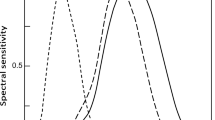Summary
-
1.
The ability to discriminate lights on difference in spectral composition is investigated in a wild rabbit.
-
2.
An automatically operated two-choice apparatus and operant conditioning is used for this purpose.
-
3.
In the ‘blue part’ of the spectrum, with reference to λ = 496 nm, the just noticable difference in wavelength (Δ λ) probably is in between -30 and -35 nm. Possibly as a result of chromatic adaptation, Δ λ was larger in the ‘green part’ of the spectrum.
-
4.
The ability to discriminate spectrally different lights points to the independence of the ‘blue sensitive’ system and the ‘green sensitive’ system in the rabbit's retina.
Similar content being viewed by others
References
Barlow, H. B. & W. R.Levick. Three factors limiting the reliable detection of light by retinal ganglion cells of the cat. J. Physiol. 200, 1–24 (1969).
Baumann, C. (1967). Das mikroskopische Bild der Receptorenaussenglieder im Frischpräparat der Kaninchennetzhaut bei farbiger Beleuchtung, v. Graefes Arch. Ophthal. 172, 125–129 (1967).
Brown, P. K. & G.Wald. Visual pigments in single rods and cones of the human retina. Science 144, 45–52 (1964).
Brown, R. H. Colour vision in the rabbit. J. gen. Psychol. 14, 83–95 (1936).
Dartnall, H. J. A. In: The eye. pp. 323–533, ed. Davson, Academic Press, New York & London (1962).
Davis, F. The anatomy and histology of the eye and orbit of the rabbit. Trans. Am. opthal. Soc. 27, 401–441 (1929).
Denton, E. J. & J. H.Wyllie. Study of the phtosensitive pigments in the pink and green rods of the frog. J. Physiol. 127, 81–89 (1955).
Dodt, E. Generalized inhibition of the retinal ganglion cells in relation to wave-length and state of adaption. Acta physiol. scand. 36, 219–228 (1956).
— & V.Elenius. Spektrale Sensitivität einzelner Elemente der Kaninchennetzhaut. Pflügers Arch. ges. Physiol. 262, 301–306 (1956).
— & J. B.Walther. Photopic sensitivity mediated by visual purple. Experientia 14, 142–143 (1958).
Duncan, C. J. & P. M.Sheppard. Continuous and quantal theories of sensory discrimination. Proc. Roy. Soc. B. 158, 343–363 (1963).
Elenius, V. Recovery in the dark of the rabbit's electroretinogram. Acta physiol. scand. 44 suppl. 150, 5–57 (1958).
Hecht, S., J. C.Peskin & M.Patt. Intensity discrimination in the human eye. II. The relation between I/I and intensity for different parts of the spectrum. J. gen. Physiol. 22, 7–19 (1939).
Kinney, J. A. S. Sensitivity of the eye to spectral radiation at scotopic and mesopic intensity levels. J. opt. Soc. Am. 45, 507–514 (1955).
Krause, R. Die Retina. Int. Mnschr. Anat. Physiol. 12, 46–186 (1895).
Ksinsik, R. Adaptive Parameter der Blauverschiebung der Spektralsensitivität des Kaninchenauges, v. Graefes Arch. Ophthal. 172, 112–124 (1967).
Lashley, K. S. The mechanism of vision: I. A method for rapid analysis of pattern-vision in the rat. J. genet. Psychol. 37, 453–460 (1930).
Marks, W. B., W. H.Dobelle & E. F.Mcnicholl. Visual pigments of single primate cones. Science 143, 1181–1183 (1964).
Menner, E. Untersuchungen über die Retina mit besonderer Berücksichtigung der ausseren Körnerschicht. Z. vergl. Physiol. 8, 761–826 (1929).
Nuboer, J. F. W. Colour vision in a rabbit. Acta physiol. pharmacol. néerl. 13, 484–485 (1966a).
— Colour discrimination tests with rabbits. Acta physiol. pharmacol. néerl. 13, 485–486 (1966b).
— Photometry in a wild rabbit. Acta physiol. pharmacol. néerl. 15, 61–62 (1969).
— The efficacy of optokinetic stimuli of different field radiances as shown to a rabbit. Pflügers Arch. ges. Physiol. 315, 215–263 (1970a).
Nuboer, J. F. W. Visual acuity measurements in a rabbit. Thesis, Utrecht (1971a).
— Photometry in rabbits. Symp. Vision in the Rabbit Doc. Ophthal. 30, 259–278 (1971b).
Sjöstrand. F. S. & S. V. Nillson. In: The rabbit in eye research, pp. 449–513. Ed. C. Thomas Springfield, Illinois (1964).
Swets, J. A., W. P.Tanner & G. B.Birdsall. Decision processes in perception. Psychol. Rev. 68, 301–340 (1961).
Washburn, M. F. & E.Abbott. Experiments on the brightness value of red for the lightadapted eye of the rabbit. J. Anim. Behav. 2, 145–180 (1912).
Watson, J. B. & M. I.Watson. A study of the responses of rodents to monochromatic light. J. Anim. Behav. 2, 1–14 (1913).
Weale, R. A. Spectral sensitivity and wave-length discrimination of the peripheral retina. J. Physiol. 119, 170–190 (1953).
Additional information
Utrecht
Rights and permissions
About this article
Cite this article
Nuboer, J.F.W. Spectral discrimination in a rabbit. Doc Ophthalmol 30, 279–298 (1971). https://doi.org/10.1007/BF00142525
Issue Date:
DOI: https://doi.org/10.1007/BF00142525




